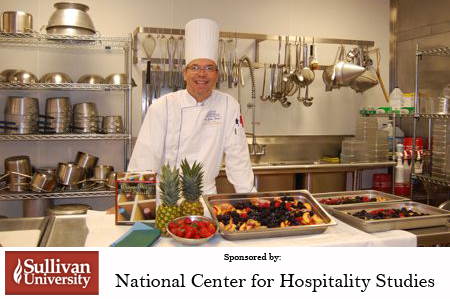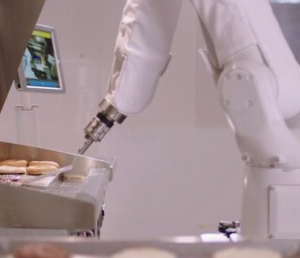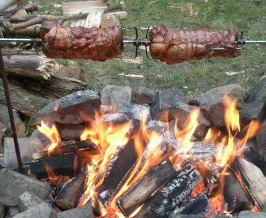I just finished reading an article about robots making food and I must confess that I’m a bit freaked out.
I like the idea of consistency as much as the next chef or restaurateur but the thought of gleaming, sleek machines pumping out food at an accelerated rate with very little human involvement blurs the lines of the creative process.
Someone has to set the concept, something could do the heavy work, but where’s the fun in that? To make matters worse this is the third time in two weeks that this topic has come up, both from a chef and a vendor asking my opinion on the trend. I can emphatically tell you that this is not a trend, it is a movement, and it’s been around since the first oven was developed thousands of years ago.

The first “robot” was fire, or the discovery that fire could cook food.
This innovation was no more startling to early man than watching a robot make your burger in 2018.
The first major update to the firepit was enclosing the fire with a top to create the oven. I’m being needlessly simplistic here to prove a point.
The efficiency of fire improved, the ability to control fire was a watershed moment, and the transmutation of fire from wood to coal to gas and electric were slow slogs through the history of cooking. Gradual, minimal in some cases, but steady, and relentless. With each new tweak, the options increased as well.
Baking of bread diversified into baking of cakes, fine pastries, and sweets. Fire roasting became just roasting, many times of the whole animal which then split into the many spiderwebs of braising, slow roasting and of course barbeque.

Burger flipping robot, made by Miso Robotics
Along the way you had many fingers in the pot, creating new dishes, formulating new techniques, all borrowing and building on the original idea. Some of these advancements enhanced the working conditions of the cook. Cooking in a cramped airless kitchen with coal wasn’t nearly as hazardous as mining that coal, but it did produce some of the same respiratory problems. The switch to electricity and gas eased some of that. That is one of the stated benefits of having a robot cook your burger, making it almost 100% clean by enclosing the smoke in the system. Whether that was the intended outcome all along is inconsequential, the fact is, we have arrived at this distant shore after a very long journey.
Now comes the hard part, as we struggle to humanize the process in an effort to not totally exclude the cook from their centuries-old craft.
Over the history of cooking and the culinary arts, the work has been done mostly by pioneers, people who either stuck out their necks on a hunch or put their shoulders to the wheel and moved it, against all odds, a few inches forward. The names are recognizable from Careme to Escoffier, Point, Child, Waters, and Keller. Many were steeped in tradition and broke away from it, a deeply personal move that took real fortitude. Some like Ferran Adria embraced a different way because it suited their restlessness.
In our profession, innovation can spring from the need for speed or efficiency, partly from ego, and sometimes from necessity. At the heart of each change was a person, steeped in skills and experience far outside the kitchen door. Which leads me to believe that true change must have triumph and failure behind it. We glimpse that even in the story of the burger bot which took years to create and will take many more to refine. If the human element is not engrained in that struggle, then where could it possibly be after all these centuries?

Cooking on an open fire. (Photo by Zeichner Matthias Juchem)
A chef’s inherent ability (and deepest need) to control their kitchen will, I think is the one variable that keeps the culinary arts connected to the human touch.
Building a machine that cooks burgers from start to finish cannot be dismissed as a fad anymore, we have caught up to the technology and shaped it to do just that. We have in effect created a new type of cook, and truth be told, one that exhibits a lot of the positives we look for in a human cook.
The one intangible that I believe is beyond technology’s reach is the innate creativity that a good cook possesses, and the desire to consistently and without fail search out the new and exciting. You can’t program desire in its many forms, nor should we attempt to. That robs art, and culture from experiencing individuality, and spontaneous collaboration.
Like a good sci-fi movie, it sets up the conflict between rigid control and unrestrained expression, which can lead to wonderful innovation or a colorless grey world. I would like to imagine that we can do with a little bit of both and that it can lead, along with a burger slinging bot, to a world more in tune with the path we are on.

John Foster is an executive chef who heads the culinary program at Sullivan University’s Lexington campus. A New York native, Foster has been active in the Lexington culinary scene and a promoter of local and seasonal foods for more than 20 years. The French Culinary Institute-trained chef has been the executive chef of his former restaurant, Harvest, and now his Chevy Chase eatery, The Sage Rabbit.
To read more from Chef John Foster, including his recipes, click here.
























